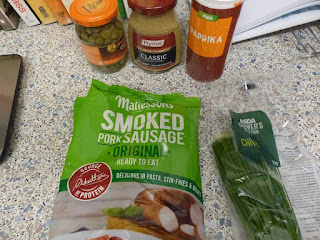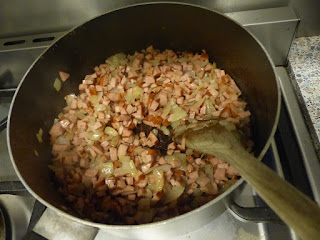Just sneaking in under the wire for "May", but they all count, right?
Besides, I've been distracted. There was the small matter of a pan-European music event to obsess over for several weeks (no, really, they rehearse for several weeks). Wasn't it ace though? With a live audience and everything. A true glittery beacon of hope for people all around the continent as we re-emerge, blinking and wide-eyed, into this thing we once called normal life.
Speaking of normal... [checks notes] Sorry, erm, beetroot and rhubarb soup?
OK, well, maybe things are still a bit strange in The Random Kitchen...
◘ THE STARTER ◘
The book: A Soup For Every Day (New Covent Garden Food Co)
The recipe: p78, "Beetroot and Rhubarb Soup"
Rules are rules, though - and so I really will be making a soup containing beetroot, rhubarb, and not a whole lot else. At least it's straightforward.
Despite it notionally being the start of rhubarb season, I can only assume the autumnal weather we've been having these last few months has had a knock-on effect, as finding the fresh stuff proves problematic within my limited local scope. So while the recipe calls for fresh rhubarb and cooked beetroot, guess what I'll be using?
 |
| That's right: the exact opposite |
Ah well, I suppose it's all getting boiled and blended in the end, isn't it? I give the peeled and diced beetroot a blast in the microwave in a vague nod to the "cooked" criterion, and on we go.
Butter is melted in a big pan, then the rhubarb is added and cooked "gently until softened". Being tinned, it already is soft, but I give it a few minutes anyway. Next, the diced beetroot is added - and I'm sure you'll agree things are already looking appetising:
Next, some vegetable stock goes into the pot and things are left to simmer for 10-15 minutes. (I make it more like 20 to account for the beetroot having started out a bit less cooked in the first place.)
And that, folks, is it. Well, not quite: First I have to let the soup cool a bit, then blend it. I wish I could share some video footage of me using a hand blender to achieve this; suffice it to say that's a light blue T-shirt I won't be wearing again.
 |
| Got there in the end though |
At this point the soup looks "silky" to the point of "mushy", but once it's had some sour cream and a few generous dashes of Cholula added for the serving - that counts as "season to taste", right? - it takes on a less rustic consistency, and all for the better.
 |
| Not forgetting the mandatory croutons |
I'm actually just eating the leftovers as I type this up, and my - our - verdict remains the same: This is pretty good! You could happily eat this chilled on a hot day too, I reckon. It has that kind of freshness to it.
As suggested by my comments above, I was initially a bit sceptical about the flavour combination, although I've been known to use rhubarb in unusual places before (steady on, I'm talking about sticking it in a curry...) and it's always worked quite well. And so it does here, too, offsetting the earthiness of the beetroot to produce a pleasant overall effect. Just not the kind of overall effect you'd want anywhere near your soft furnishings.
One-word verdict: Vivid.
◘ THE MAIN COURSE ◘
The book: My red recipe folder
The recipe: "Kothu Parotta"
Like so many of the recipes in my folders o' random stuff, this one was downloaded on a whim and promptly forgotten about again. The inspiration will undoubtedly have been a takeaway from Everest Curry King on Loampit Hill - despite the name, actually a Sri Lankan restaurant, and the secret (though nowadays perhaps not-so-secret) star of the local food scene. Affordable, friendly and generally bloody excellent, it's the eatery we frequent perhaps more than any other, if only for the anecdotes:
And while I certainly can't be bothered to make mutton rolls at home, it makes sense that I'd have downloaded a recipe for kothu parotta (or kottu roti, or any number of variations and transliterations). It's simple street food - as the blurb here says, often served "for breakfast, brunch or just a snack" - and while my go-to Everest order includes spicy lamb, its origins are as a simple vegetarian dish and one that feels very achievable even in a home kitchen.
And so that's what we're going to make for today's main course - not a bad thing, after a hearty soup starter.
The key ingredient here is the parotta/paratha/roti/flatbread. While the recipe suggests you take three and break them into small pieces, one of the beautiful things about living near a row of Sri Lankan businesses is their well-stocked freezer units that contain things like this:
Yep, this dish is sufficiently ubiquitous that you can buy pre-shredded frozen parotta. So, of course, I do. I'm lazy like that - plus it's one way of making sure you've cut it to the right size, given the recipe doesn't have a lot to say about that...
Said "recipe" is mainly just a collection of spices and accompaniments added as we go. For instance: Oil goes into the pan and is heated, followed by some mustard seeds until they pop, followed by some curry leaves, followed by a finely chopped onion, followed by some minced ginger, followed by some finely chopped green chillies "to taste". I'm wary about going too extreme here so I opt for two chillies, seeded. Often I'd leave the seeds in, but I don't want to overpower things unnecessarily.
A diced tomato goes in next. Once that's softened, some chaat masala, garam masala, red chilli powder ("to taste" again) and salt are stirred through. And then it's time to tip in the packet of chopped parotta, stir it to mix, and cook it until it's heated through.
While this is happening, I take the opportunity to chop some coriander, some of which is going to go in the dish and some of which is going to garnish it at the end. No actual quantity is given in the recipe (a theme is developing here, isn't it?), but I already know the only correct amount of coriander is "lots":
 |
| A modest portion |
Most of that goes into the pan, and once it's wilted down a bit, things begin looking very promising indeed:
 |
| O hai |
And finally, the part that makes this more of an obvious breakfast/brunch dish: two eggs! These are just broken straight into the pan and scrambled/cooked/tossed until little bits of egg are coating pretty much everything. Again, super simple.
Because I'm serving this in small bowls (by our greedy standards, anyway) and there's still plenty of coriander left over as a garnish, I'm afraid the photo of the end result doesn't especially do it justice, since all you can really see here is a bunch of leaves.
But the eating definitely does do it justice. This isn't quite Everest quality - I suspect using ghee and more salt, as a restaurant inevitably will, makes a taste difference as well as a waistline difference - and I actually could have gone a bit harder on the green chillies and/or the chilli powder. But all in all, this is a warming, tasty and incredibly straightforward dish that I'd recommend anyone to have in their armoury.
(Or if you're looking for a post-Covid career change, you could stick three prawns on top and easily charge £8 for it at the Model Market.)
One-word verdict: Easy-peasy.
◘ THE DESSERT ◘
The book: Riverford Farm Cook Book
The recipe: p355, "Quick Strawberry Ice Cream"
Don't worry, it's not going to be all good this month.
I shan't waste too much time on this relentlessly disappointing excuse for ice cream, not least since it's yet another dessert based around mushing up some strawberries, and there's really only so much you can write about that. But I owe it to the cookbook to at least dissect its mistakes to some extent, so here goes.
First of all: This isn't ice cream, it's frozen yoghurt. Sure, there's double cream involved too, but - at the risk of channelling Holly and the Talkie Toaster - the prevailing mood is decidedly yoghurty.
For a dessert, it's not especially sweet, either.
Anyway, let's start at the beginning. That means whizzing some strawberries in a food processor with a little honey, a dash of orange juice and a couple of spoonfuls of red wine, because red wine is obviously the first ingredient that comes to mind when you think "ice cream". This then gets set over a sieve to sift out some of the more sizeable seeds.
Meanwhile, I take the aforementioned double cream and full-fat yoghurt and beat it using an electric mixer until "soft peaks" are formed. My mixture never seems to reach peak peak (so to speak), which might be one reason for the subsequent problems, but there's only so much patience a man can have, so I press on.
The white stuff then gets folded into the red stuff until combined. Now, I'm no expert but I'm pretty sure that folding is meant to be gentle and not too protracted or vigorous, lest the air I've just whipped into the cream and yoghurt get beaten straight out of it again.
So it's not altogether surprising to me that folding, in this case, leaves me with... well, there's no way around it: Doctor, there's lumps in my ice cream.
With further folding doing little to alleviate the situation, I decide there's only one thing for it: Stick it in the freezer and hope for the best!
Several hours later, and...
The best has not magically occurred. It's still lumpy. And looking delicious! [sarcmark]
Whether it's because of the inadequate mixing process or something else, the texture of this "ice cream" clearly isn't what it ought to be either. At least, I'm assuming it's not meant to have crystallised to such an extent that it only comes out of the container as one big lump or many glassy shards.
 |
| Ahh, the two main food groups |
Now, it does taste all right, I'll give it that. Could be sweeter, but using riper strawberries would have helped there (beggars can't be choosers where Lewisham shopping is concerned), and I could have anticipated that and made adjustments.
But ultimately... well, as Sam puts it, "I'm sure ice cream isn't meant to be crunchy".
One-word verdict: Disappointment.









 No need for smoke and mirrors this month: I really do make all three of these dishes on the same day and serve them as part of the same (extended) meal. A true Random Menu for once!
No need for smoke and mirrors this month: I really do make all three of these dishes on the same day and serve them as part of the same (extended) meal. A true Random Menu for once!































 ," he replies.
," he replies.












